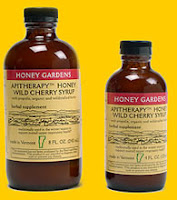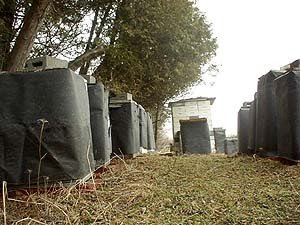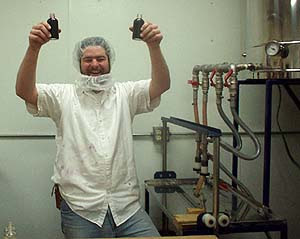Wild Cherry – Botanical Treasure
Our northern woods, fields, and wetlands are rich in botanical treasures. Many of these plants are medicinal as well. In particular,Vermont transitional forests are home to one of our most valued medicinal trees, the wild cherry, or Prunus serotina. We value the wild cherry for its inner bark which is a main ingredient in our wild cherry cough syrup.
Unlike commercial cough medicines which are typically flavored, colored, and sweetened as if containing actual cherry fruits, our formula is made the way traditional wild cherry bark cough syrups have been made since the nineteenth century. It is the bark rather than the fruit that is more therapeutic and medicinal. Of specific influence and inspiration to our formula is Dr. D.C. Jarvis, a twentieth century Vermont folk medicine country doctor, whose use of both apple cider vinegar and raw honey in treating coughs is tried and true. Our Apitherapy wild cherry syrup contains a base of raw honey and organic apple cider vinegar to which we add organic and wild crafted herbs and propolis.
 Contained within our vision is the intention of wildcrafting sustainably, never depleting natural populations of wild medicine plants. Todd’s brother-in-law is a forester and alerted him that some cherry trees had been cut down and bark would be available from sections of logs that were too small to be marketable. Tim and Carol of the honey house crew carefully removed first the outer bark which is not used, and then the prized inner bark for our syrup. This is a wonderful example of the choreography of sustainable practice: agriculture working in tandem with forestry.
Contained within our vision is the intention of wildcrafting sustainably, never depleting natural populations of wild medicine plants. Todd’s brother-in-law is a forester and alerted him that some cherry trees had been cut down and bark would be available from sections of logs that were too small to be marketable. Tim and Carol of the honey house crew carefully removed first the outer bark which is not used, and then the prized inner bark for our syrup. This is a wonderful example of the choreography of sustainable practice: agriculture working in tandem with forestry.
There is a bit of irony surrounding the naming of our plant medicine, the wild cherry syrup. Although ingredients in our formula have been used traditionally to treat coughs at least since the early nineteenth century (and volumes of anecdotal evidence support their success rate), we cannot label our syrup a cough syrup because it does not contain one of the chemicals that the FDA deems necessary to include for such labeling.
Our wild cherry syrup is pure plant  medicine. It acts as a respiratory relaxant, an anti-inflammatory and demulcent for inflamed respiratory tissues, and an antitussive for relieving irritating, relentless, and spasmodic coughs. The propolis and raw honey contribute antibiotic action, making this a very effective product.
medicine. It acts as a respiratory relaxant, an anti-inflammatory and demulcent for inflamed respiratory tissues, and an antitussive for relieving irritating, relentless, and spasmodic coughs. The propolis and raw honey contribute antibiotic action, making this a very effective product.
to order Apitherapy honey wild cherry syrup, Apitherapy honey, and more, via credit card from our website click here
Apitherapy raw honey is important for maintaining health, too, because it is one of the eight or so foods that are very high in enzymes.

